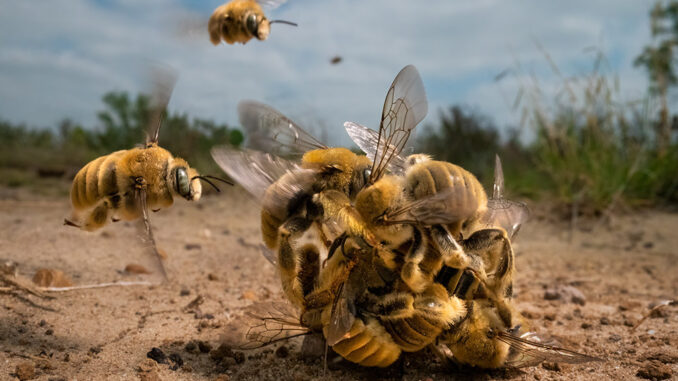
Check out the top 15 best wildlife photos!

Wildlife photography is one of the most challenging genres of photography. You are photographing animals in their natural habitat respecting and maintaining their space without the ability to direct them as subjects of the shoot. And to capture the best wildlife photos, you have to go the extra mile.
Inspiration for wildlife photography can come from your local area, the garden, urban locations as well as the countryside and coast. You might choose to fill the frame with the head of a majestic lion, capture the abstract shapes of a starling murmuration, or show an urban fox in an inner-city context.
Research, patience, timing, as well as technical excellence, will be the deciding factor between an average shot and an outstanding one. But remember, the priority for wildlife photography is the animal and safety.
Below is a selection of photographs that demonstrate the very best of wildlife photography…
The best wildlife and animal photos
Cities gone wild by Corey Arnold

City Howl. Photo credit: © Corey Arnold, United States, 1st Place Winner, Professional competition, Wildlife & Nature, Sony World Photography Awards 2023.
‘A coyote yips aggressively at an off-leash dog park in San Francisco, California. This park is surrounded by densely placed residential buildings on all sides and is the unlikely territory for a pack of urban coyotes. Coyotes have become a greater presence in San Francisco, but conflicts with dogs and cats, who occasionally become prey are also increasing.
Cities Gone Wild is an exploration of three savvy animals — black bears, coyotes and raccoons — that have uniquely equipped to survive and even thrive in the human-built landscape while other animals are disappearing. I tracked these animals in cities across America to reveal a more intimate view of how wildlife is adapting to increased urbanisation.’
Arnold won 1st place in the Professional competition, Wildlife and Nature, Sony World Photography Awards 2023.
Crested Caracaras by Dinorah Graue Obscura
‘While I was shooting Crested Caracaras in flight in South Texas, I noticed these two, which were perched in a very similar way. They were staring in the same direction and not moving, almost as if they were posing for me. I was amazed by their powerful personalities.’
Dinorah Graue Obscura emerged as the 2023 Open Photographer of the Year at the recent Sony World Photography Awards.
The Big Buzz by Karine Aigner
The Big Buzz by Karine Aigner, USA Winner, Behaviour: Invertebrates and Wildlife Photographer of the Year Sony A7R III, Laowa 24mm f/14 2x macro probe lens, 1/1000sec, ISO 6400; Profoto strobe and wireless trigger
The Big Buzz by Karine Aigner, USA. Winner, Behaviour: Invertebrates and Wildlife Photographer of the Year 2022. Sony A7R III, Laowa 24mm f/14 2x macro probe lens, 1/1000sec, ISO 6400; Profoto strobe and wireless trigger.
Karine Aigner captured this flurry of activity as a ball of cactus bees spun over the hot sand of a Texas ranch. After a few minutes, the pair at the centre of the ball – a male clinging to the only female bee in the scrum – flew away to mate. The world’s bees are impacted by habitat loss, pesticides and climate change. 70% of bee species nest underground, so it’s increasingly important that natural soil is left undisturbed. The photo took the grand prize of Wildlife Photographer of the Year at an annual competition developed and produced by the Natural History Museum.
Heavenly Flamingos by Junji Takasago
Heavenly Flamingos by Junji Takasago, Nikon Z 7, 80-400mm f/4-5.6 at 400mm, 1/3200sec at f/10, ISO 800
Heavenly Flamingos by Junji Takasago, Nikon Z 7, 80-400mm f/4-5.6 at 400mm, 1/3200sec at f/10, ISO 800
This ethereal and stunning image won the ‘Natural Artistry’ category of Wildlife Photographer of the Year 2022, and it’s not hard to see why.
The flamingos seen here are sitting on the world’s largest salt pan in southwest Bolivia. It’s sometimes known as the ‘mirror in the sky’, with the reflection shown in the shot part of its minimalist appeal. But, the salt pan is also home to one of Bolivia’s lithium mines – the very thing inside many of our devices, including smartphones and cameras. The mining of this resource is threatening the future of the area’s flamingos. Reuse and recycling of electronics are vital to preserving natural resources and habitats for many animals and birds such as flamingos.
The photographer, Junji, had to battle through altitude sickness to get the shot – a testament to how far we’ll go for our art.
Sleeping with Dandelions by Lewis Newman
British Wildlife Photography Awards, Lewis Newman
Sleeping with Dandelions. Nikon D500 with Nikon 300mm f/2.8 lens. 300mm; 1/800th second; f/4; ISO 640. Credit: BWPA/Lewis Newman
After spending a lot of time with this particular vixen, she began to learn I was not a threat. This gave me some great photographic opportunities. I got to know her routine, and as the wildflowers began to grow, I would find her curled up amongst them. As the dandelions began to open there were a couple of days when she would wake up covered in them. Although she got used to my presence, if I were to move too fast or drop anything she would immediately leave. Later on in spring, I was blessed with her bringing her cubs to me and have watched them grow ever since.’
This was the winning image of the British Wildlife Photography Awards 2023 in the category of Animal Portraits.


Be the first to comment